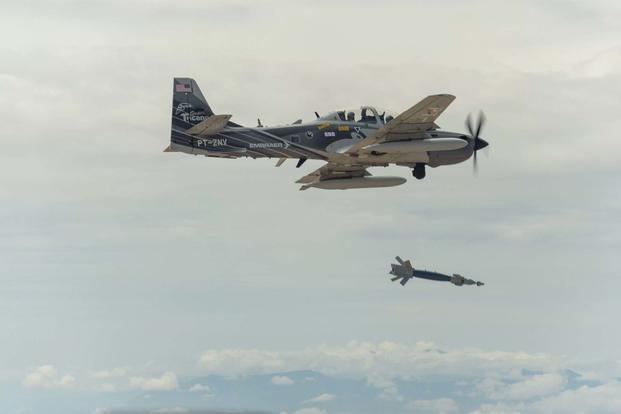The U.S. Air Force has put in a new order with Sierra Nevada Corp. and Embraer to produce six new A-29 Super Tucano aircraft for the Afghan air force's fleet, the companies announced Wednesday.
"We believe this decision demonstrates that the A-29 Super Tucano is the best aircraft for close air support operations, as well as the most proven, reliable and cost-effective solution for counterinsurgency and irregular warfare scenarios," said Jackson Schneider, president and CEO of Embraer Defense & Security.
"We are honored to continue to support the U.S. government in this critical mission," Schneider said in a release.
A U.S.-funded $427 million contract calls for a total of 20 turboprop A-29s to be delivered to Afghanistan by 2018.
Related content:
- From Old Pilots to New Planes, Air Force Chief Talks 'New Ways of Doing Business'
- Air Force Wants Ban Exemption for Iraqi Pilot Trainees
- A-29 Super Tucano Attack Aircraft See First Action in Afghanistan
Without disclosing a fixed price, officials said production of these six new aircraft is scheduled to start "immediately in Jacksonville, Florida, and brings to 26 the total number of aircraft provided to the program," the release said.
"There is no other aircraft like the A-29 in its ability to provide flight training, light attack, and combat pilot seasoning," said Taco Gilbert, senior vice president for SNC's ISR business area and a retired Air Force brigadier general. "Its continued demand demonstrates its value to air forces the world over."
Last April, A-29s manned by Afghan pilots trained in the U.S. conducted their first close-air support missions in fixed-wing aircraft in Afghanistan.
Four of the A-29s arrived in Afghanistan in January 2016 and another four previously flew into a military airfield near Hamid Karzai International Airport outside Kabul, according to Army Brig. Gen. Charles Cleveland, then the deputy chief of staff for communications for the U.S. and NATO Resolute Support Mission in Afghanistan.
"They are beginning to take their first strikes," guided to targets by Afghan forward air controllers on the ground, Cleveland said at the time.
The four A-29s were delivered one month after the first Afghan pilots and crew for the attack plane completed training at Moody Air Force Base, Georgia.
The program, which began in 2015, will ultimately train 30 pilots and 90 maintainers through 2018 at the base, according to the Air Force.
The U.S. military services have an ongoing train, advise and assist mission in Afghanistan. The Afghans have been using A-29s for close-air attack, air interdiction, escort and armed reconnaissance.
Meanwhile, the Super Tucano is active or has been selected by 13 air forces worldwide for close-air support missions.
The A-29 is also an aircraft being considered by the U.S. Air Force.
The Air Force in August conducted a "light attack experiment" at Holloman Air Force Base, New Mexico, in which four aircraft -- AirTractor and L3's AT-802L Longsword; Sierra Nevada and Embraer's A-29 Super Tucano; and Textron and AirLand LLC's Scorpion, as well as their AT-6B Wolverine -- conducted live-fly exercises, combat maneuver scenarios and, on some occasions, weapons drops.
The service could bring in a new turboprop aircraft -- known as OA-X light attack planes -- if it sees value.
OA-X "is actually not about the hardware -- it's about the network," said Air Force Chief of Staff Gen. David Goldfein during a recent interview with Military.com
He wants the Air Force to train more often with coalition partners -- who may not have high-end fighter aircraft. Goldfein, who served as the U.S. Air Forces Central Command commander between 2011 and 2013, said, "Is this a way to get more coalition partners into a network to counter violence?"
"Can I at the same that we're looking at a relatively inexpensive aircraft and sensor package, can I connect that into a network of sharable information that allows us to better accomplish the strategy as its been laid out?" he said.










